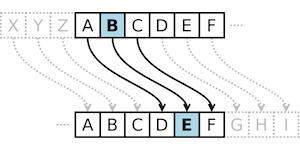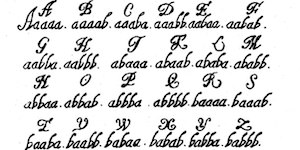Vernam cipher

The Vernam cipher is a symmetric stream cipher based on the exclusive-or (XOR) operation. In this cipher, the original text (plaintext) is encrypted bit-by-bit using a random key.
The Vernam cipher encryption algorithm can be represented as follows:
- The original text is broken into sequences of bits.
- For each sequence of bits of the plaintext, the corresponding bit of the key is selected.
- The exclusive-or operation is performed bit-by-bit on the bits of the plaintext and the bits of the key.
- The result of the exclusive-or operation is the ciphertext.
The Vernam cipher decryption algorithm is analogous to the encryption algorithm. The same key that was used for encryption is used for decryption.
History
The Vernam cipher was invented by American engineer Gilbert Vernam in 1917. Vernam was working on the creation of a cipher system for the teletype. He wanted to create a cipher that would be absolutely secure, meaning that it could not be broken.
Vernam hypothesized that if a random sequence of bits were used for encryption, then such a sequence would be unpredictable to an attacker. If the key were truly random, then for the cipher to be broken, the attacker would need to know the entire key.
Vernam proposed using a noise generator to generate a random sequence of bits. He believed that such a generator would be able to provide a truly random sequence.
The Vernam cipher was first used for military purposes during World War I. It was used to transmit secret messages between military units.
Here are some milestones in the development of the Vernam cipher:
- 1917: Gilbert Vernam invents the Vernam cipher.
- 1918: The Vernam cipher is first used for military purposes during World War I.
- 1945: Claude Shannon proves the absolute security of the Vernam cipher.
- 1950s: The Vernam cipher begins to be used for commercial purposes.
- 1970s: The development of public-key cryptography leads to a decline in the popularity of the Vernam cipher.
Key requirements
The Vernam cipher has special requirements for the key to ensure maximum security:
- Length: The length of the key must be at least as long as the length of the plaintext message. If the key is shorter than the plaintext, it must be repeated to match the length of the plaintext, which could potentially reveal patterns and reduce the security of the encryption.
- Content: Ideally, the symbols in the key should be truly random and not follow any predictable pattern. Any predictability in the key could potentially be exploited by an attacker to break the encryption.
- Use: Each key should be used only once and then discarded. Using the same key more than once (also known as key reuse) can provide attackers with valuable information, making the encryption vulnerable to attacks.
It is also important to emphasize that safe distribution and storage of the key is a critical aspect. If the key is revealed or guessed, the security of the Vernam cipher is completely compromised.
In practical applications, meeting these requirements can be a challenge. This is why the Vernam cipher, despite its theoretical security, has not been widely adopted in most cryptographic systems. It is used primarily in cases where absolute security of encryption is required. For example, the Vernam cipher is used for military purposes to transmit secret messages.
Here are some advantages of the Vernam cipher:
- Absolute security, if the key is truly random.
- Simplicity of implementation.
Here are some disadvantages of the Vernam cipher:
- Requires a key of length equal to the length of the message.
- Complexity of ensuring the confidentiality of the key.
Comments on the service

Caesar shift is a type of cipher in which each character is replaced by a character shifted by a certain number in the alphabet.
Go to calculation
A simple substitution cipher for alphabetical writing in which the n-th letter of the alphabet is replaced by the letter m - n + 1.
Go to calculation
A two-letter binary cipher in which alphabet letters are replaced by symbols 'A' and 'B' based on binary coding rules and principles.
Go to calculation